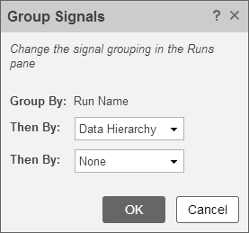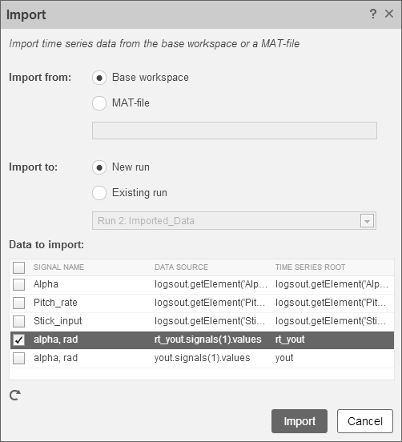Simulation and Code Comparison
This example shows how to verify the answers computed by code
generated from the slexAircraftExample model. It
shows how to capture and compare two sets of output data. Simulating
the model produces one set of output data. Executing the generated
code produces a second set of output data.
Note
To obtain a valid comparison between model output and the generated code, use the same Solver selection and Step size for the simulation run and the build process.
Configure Signal Data for Logging
Configure the model for logging and recording signal data.
Make sure that
slexAircraftExampleis closed. Clear the base workspace to eliminate the results of previous simulation runs. In the Command Window, type:clear
The clear operation clears variables created during previous simulations and all workspace variables, some of which are standard variables that the
slexAircraftExamplemodel requires.To open the model, in the Command Window, enter:
.openExample('slexAircraftExample')In the model window, choose File > Save As, navigate to the working folder, and save a copy of the
slexAircraftExamplemodel asmyAircraftExample.Set up your model to log signal data for signals:
Stick,alpha,rad, andq, rad/sec. For each signal:Right-click the signal. From the context menu, select Properties.
In the Signal Properties dialog box, select Log signal data.
In the Logging name section, from the drop-down list, select
Custom.In the text field, enter the logging name for the corresponding signal.
Signal Name Logging Name StickStick_inputalpha,radAlphaq, rad/secPitch_rateClick Apply and OK.
For more information, see Save Signal Data Using Signal Logging.
In the Configuration Parameters dialog box:
Set Type to
Fixed-step.Set Format to
Structure with time.Clear the States check box.
Select the Signal logging check box.
Select the Record logged workspace data in Simulation Data Inspector check box.
Save the model.
Proceed to Log Simulation Data.
Log Simulation Data
Run the simulation, log the signal data, and view the data in the Simulation Data Inspector.
Run the model. When the simulation is done, on the Simulink® Editor toolbar, the Simulation Data Inspector button is highlighted to indicate that new simulation output is available in the Simulation Data Inspector.

Click the Simulation Data Inspector button to open the Simulation Data Inspector.
Group the signals:
On the Visualize tab, click Group Signals.
In the Group Signals dialog box, select
Data Hierarchyfrom the Then By list.
Click OK.
Click the
logsoutexpander to view the logged signals.Click the Format tab.
Click the Subplots button and select
3x1to show three subplots.For each signal:
Click the top subplot. A blue border indicates the plot selection.
Select the check box next to the
Alphasignal name. The signal data appears in the subplot.Plot the
Pitch_ratesignal in the middle subplot.Plot the
Stick_inputsignal in the bottom subplot.

Proceed to Run Executable and Load Data.
Run Executable and Load Data
You must rebuild and run the myAircraftExample executable
to obtain a valid data file because you have modified the model.
In the Configuration Parameters dialog box, set the MAT-file variable name modifier parameter to
rt_.rt_is prefixed to each variable that you selected for logging in the first part of this example.Click Apply and OK.
Save the model.
To generate code, on the C Code tab, click Build button.
When the build is finished, run the standalone program from the Command Window.
!myAircraftExample
The executing program writes the following messages to the Command Window.
** starting the model ** ** created myAircraftExample.mat **
Load the data file
myAircraftExample.mat.load myAircraftExample
Tip
For UNIX® platforms, run the executable program in the Command Window with the syntax
!./executable_name. If
preferred, run the executable program from an OS shell with the syntax
./executable_name. For more
information, see Run External Commands, Scripts, and Programs.
Proceed to Visualize and Compare Results.
Visualize and Compare Results
When you follow the example sequence that began in Configure Signal Data for Logging, you obtain data from a Simulink run of the model and from a run of the program generated from the model.
To view the execution output for
alpha,rad, import the data into the Simulation Data Inspector.On the Simulation Data Inspector Visualize tab, click the Import button to open the Import dialog.
Specify Import from as Base workspace.
Specify Import to as New run.
To the left of Signal Name, click the check mark to clear the check boxes.
Select the check box for the
alpha,raddata where the Time Series Root isrt_yout.Click Import.

The selected data is now under Run 2: Imported_Data.
View a plot of the executed data.
Click the
rt_youtexpander.Click the top subplot and select the check box next to the
alpha, radsignal name. The signal data appears in the top subplot.The
alpha, radsignal from Run 1 and Run 2 overlap in the subplot because the signals are equivalent.

It is possible to see a very small difference between simulation and code generation results. A slight difference can be caused by many factors, including:
Different compiler optimizations
Statement ordering
Run-time libraries
For example, a function call such as sin(2.0) can
return a slightly different value depending on which C library you
use. Such variations can also cause differences between your results
and these results.
Compare States for Simulation and Code Generation
The order in which Simulink logs states during simulation is different than the order in which Simulink Coder™ logs states during code generation. If you want to compare states between simulation and code generation, sort the states by block name.
For example, by default, Simulink exports state data to
the MATLAB variable, xout. Simulink
Coder exports
state data to the variable rt_xout. To sort the
state data for these variables, enter the following commands in the
MATLAB Command Window:
[~,idx1]=sort({xout.signals.blockName});
xout_sorted=[xout.signals(idx1).values];
[~,idx2]=sort({rt_xout.signals.blockName});
rt_xout_sorted=[rt_xout.signals(idx2).values];You can confirm that the logging order is the same between code generation and simulation by entering the following command in the MATLAB Command Window:
isequal(xout_sorted, rt_xout_sorted)